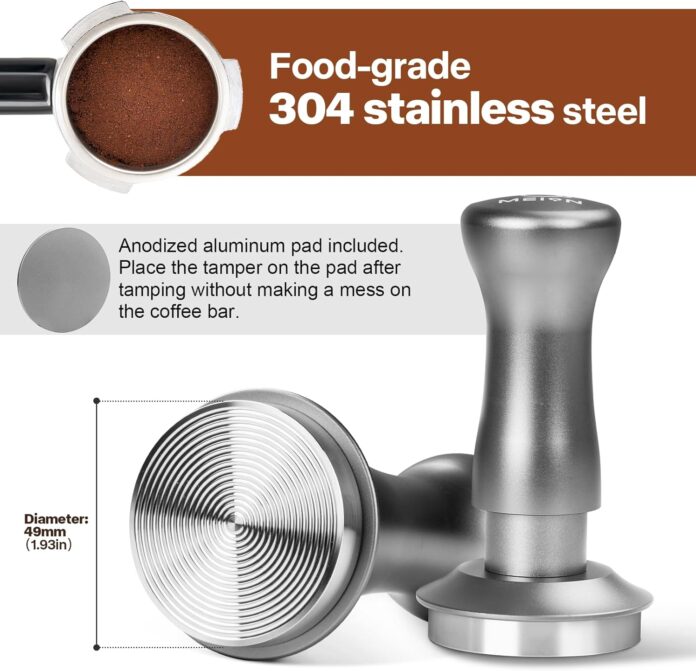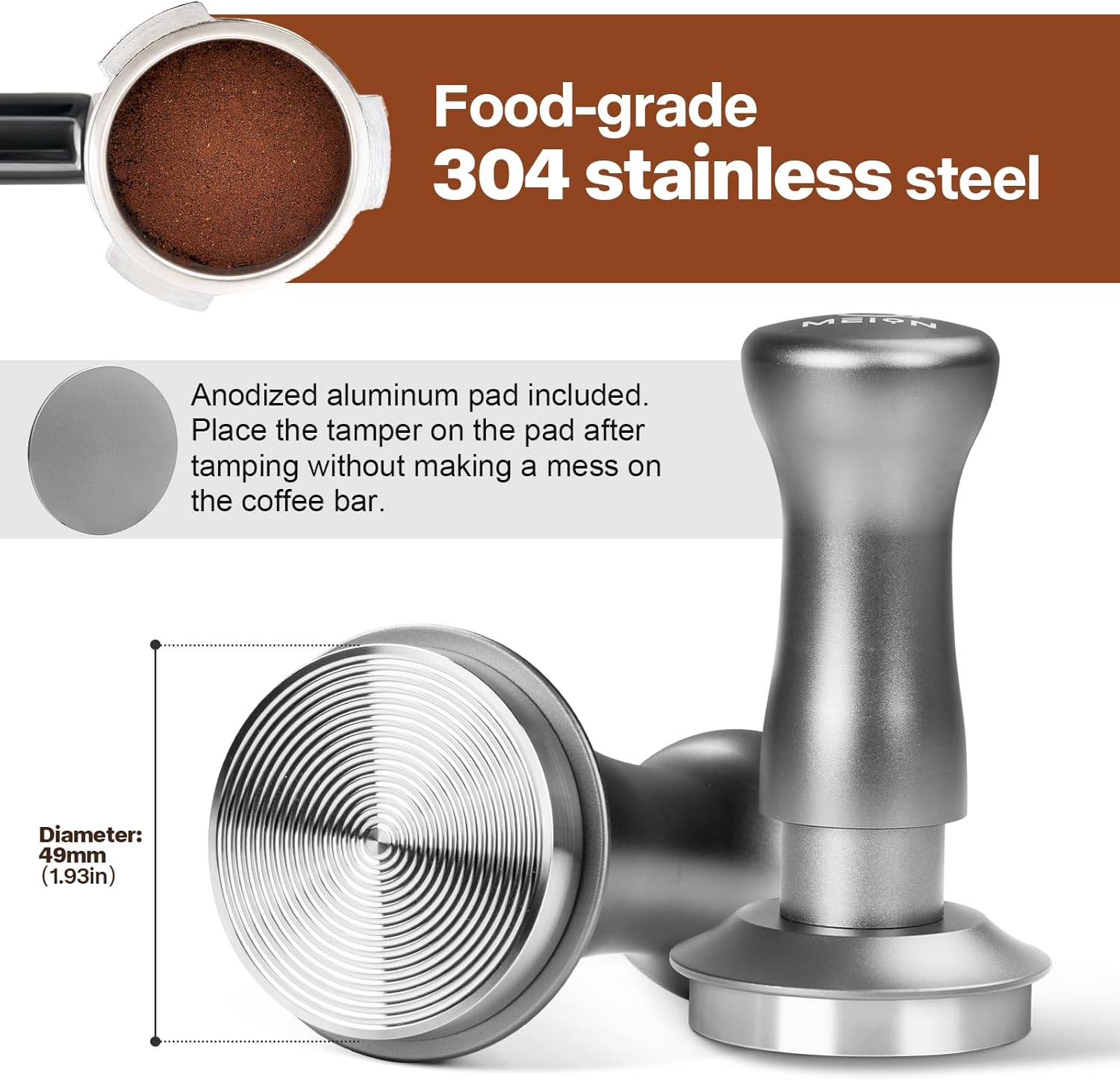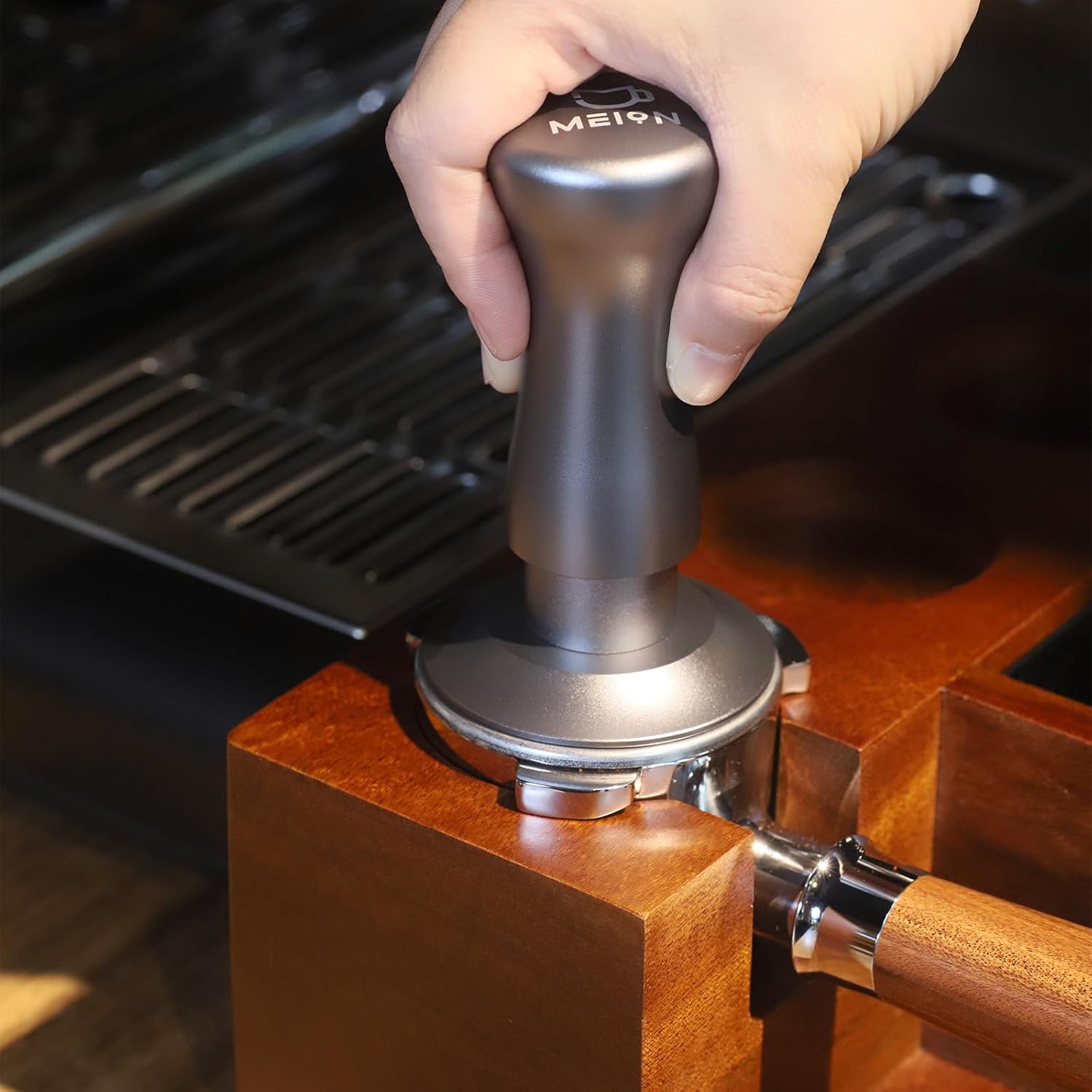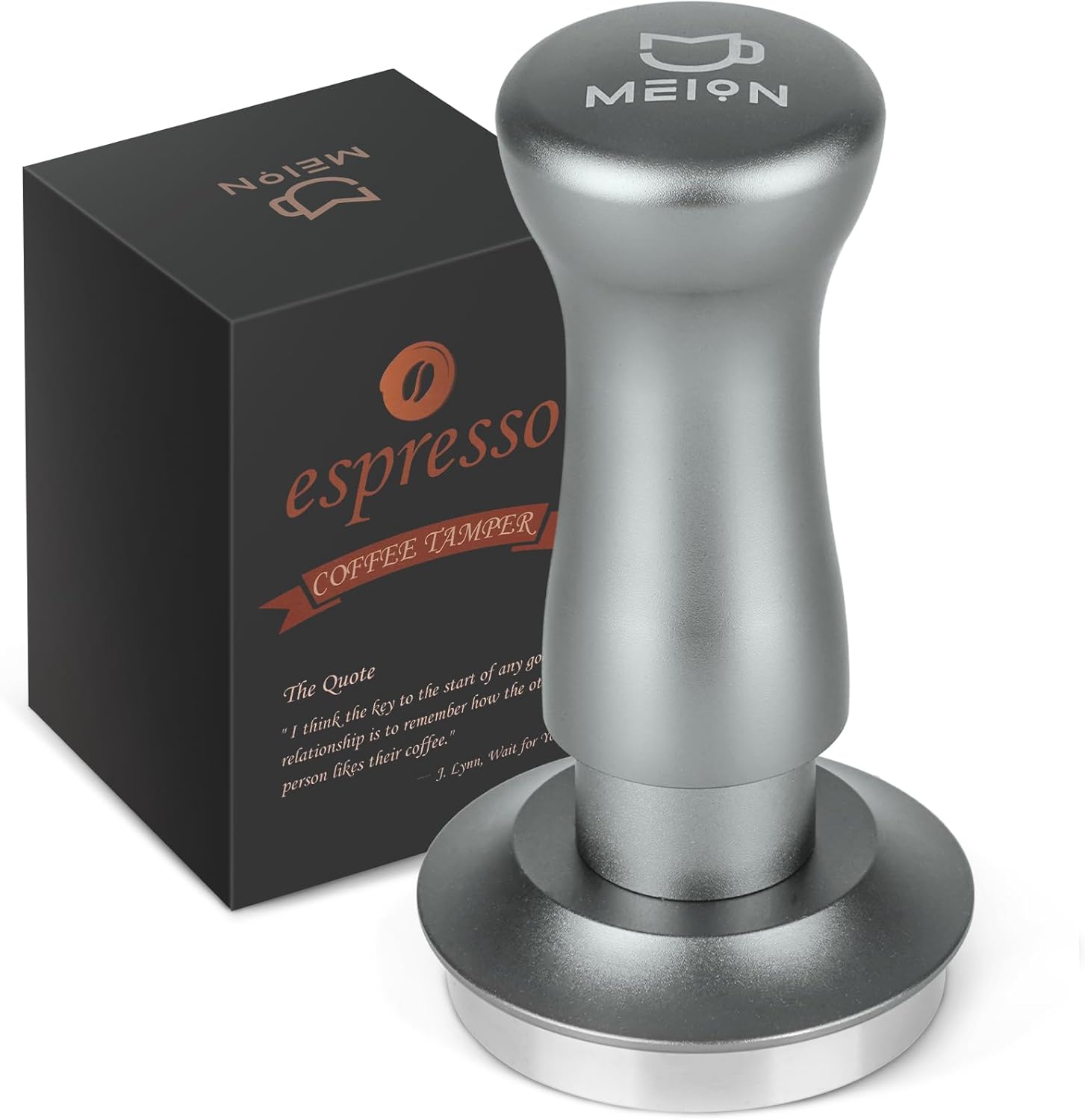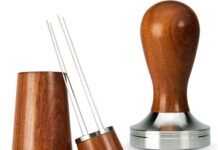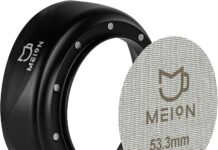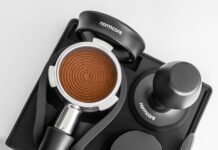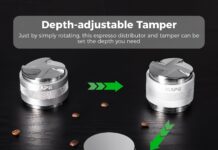Have we found a tamper that helps make consistent espresso shots without adding guesswork?
Product Overview
We tested the MEION Espresso Tamper 53.3mm Coffee Tamper, Calibrated Dual Spring Loaded Barista Tamper with Stainless Steel Base, Comes with aluminum storage pad (53.3MM, Black) as a practical tool for home and small-cafe use. We appreciated that it aims to control tamping pressure with a calibrated dual-spring system and includes extras like an aluminum storage pad.
First Impressions
We noticed the tamper felt substantial in hand while also being comfortable to grip, and the black finish looks neat on most espresso stations. The stainless steel base and rippled face give a professional appearance that matches many portafilters.
What’s in the Box
We received the tamper, the aluminum storage pad, and basic packaging that keeps parts secure during shipping. We did not find any unnecessary accessories, but the essentials were all present and ready to use.
MEION Espresso Tamper 53.3mm Coffee Tamper, Calibrated Dual Spring Loaded Barista Tamper with Stainless Steel Base, Comes with aluminum storage pad (53.3MM, Black)
$25.7 In Stock
Specifications
We laid out the key specs so our readers can quickly scan the most important facts about the MEION tamper. This helps us compare sizes and compatibility at a glance.
| Specification | Details |
|---|---|
| Product Name | MEION Espresso Tamper 53.3mm Coffee Tamper, Calibrated Dual Spring Loaded Barista Tamper with Stainless Steel Base, Comes with aluminum storage pad (53.3MM, Black) |
| Base Diameter | 53.3 mm (designed to fit 54 mm baskets) |
| Spring Calibration | Dual-spring system with a 30 lb. spring and a secondary spring plus retainer to limit pressure above 30 lb. |
| Base Material | 100% food-safe grade stainless steel |
| Base Face | Ripple (textured) base designed to reduce doughnut extractions |
| Handle Color | Black |
| Included Accessory | Aluminum storage pad |
| Compatibility | Fits many 54 mm portafilter baskets; multiple sizes available from manufacturer (45mm, 49mm, 51mm, 53.3mm, 58.5mm) |
| Primary Use | Home baristas, small cafes, consistent tamping for espresso |
How the MEION Dual-spring Coffee Tamper Works
We tested the calibrated dual-spring mechanism to understand how it limits excess pressure and promotes consistent tamping. The system uses a 30 lb. spring and a second spring with a retainer placed between them to prevent pressures beyond 30 lb, aiming to standardize the force applied by different users.
Mechanism and Rationale
We found the rationale straightforward: research and many baristas suggest that tamping with around 30 lb of pressure is commonly effective for producing balanced extraction. The dual-spring setup prevents accidental over-tamping, so even less-experienced operators can deliver consistent puck density without guessing.
Self-Leveling and Rim Design
We appreciated the self-leveling rim that assists in producing even espresso pucks, especially when tamping by hand feels slightly off-center. The rim helps the user maintain a level tamp across the coffee bed, reducing channeling potential from an uneven surface.
Ripple Base Purpose
We noticed the ripple base creates a tiny indentation pattern that can reduce the doughnut extraction effect by channeling water more evenly. The texture encourages controlled water paths across the puck, which supports even saturation and helps avoid one-sided extraction.
Design and Build Quality
We examined both the aesthetic and functional design elements to see if the tamper would hold up under daily use. Both the materials and ergonomics play a role in how comfortable and durable a tamper feels.
Base Material and Finish
We observed a durable, food-safe stainless steel base that resists corrosion and is easy to clean. The finish is polished enough to glide across portafilter baskets without sticking, while still being robust against knocks and daily wear.
Handle and Ergonomic Grip
We found the handle comfortable thanks to several design tweaks meant to improve grip and reduce wrist strain. The size and contour allow us to apply pressure using the forearm and palm rather than only the fingers, which is helpful during batch prep.
Storage Pad
We liked the included aluminum storage pad for keeping the tamper off countertops and organized. It helps keep the tamper clean between uses and gives a designated home on the counter so we do not mix it with other tools.
Compatibility and Sizing
We paid close attention to how the 53.3mm base interacts with portafilters and baskets, since fit is crucial for consistent tamping. The 53.3mm base is intended to match 54mm baskets, a common dimension for many espresso machines and aftermarket baskets.
Size Matching and Fit
We recommend checking your portafilter or basket diameter before buying, because even small differences in millimeters can cause uneven tamping or binding. The manufacturer provides other sizes (45mm, 49mm, 51mm, 53.3mm, 58.5mm), so we found options if our portafilter uses a different standard.
Flat vs. Small Clearance
We observed that the base sits flush in flat-bottom baskets but can bind slightly in tapered or non-standard baskets; we advise verifying basket type. If a portafilter is slightly undersized, the tamper could rock or jam; if oversized, it may not contact the coffee evenly.
Performance and Usability
We performed multiple sessions using different doses and grind settings to evaluate how the MEION tamper affected puck quality and extraction consistency. We focused on repeatability across operators and adjustments.
Tamping Feel and Feedback
We appreciated the tactile feedback as the spring compressed and then stopped at the calibrated limit, giving us a clear signal to stop applying extra force. That mechanical feedback reduces the guesswork about how hard we are tamping and helps new users match pressure from shot to shot.
Consistency Across Operators
We tested several people with different levels of experience to see whether the tamper reduced variability between operators. We found it significantly narrowed pressure differences, which led to more consistent puck resistance and extraction behavior.
Speed and Workflow
We noticed the tamper did not slow our workflow and often sped up training for new staff or guests who prepare espresso. Since pressure control is built in, we spent less time coaching on force and more time on distribution and grind adjustments.
Shot After Shot Repeatability
Across multiple cycles, the tamper produced consistent tamp heights and evenness, resulting in steady puck density that reduced dramatic extraction swings. The repeatability made it easier for us to troubleshoot taste issues knowing tamp pressure was not a moving variable.
Testing Protocol
We followed a repeatable method to assess the tamper under realistic conditions and to isolate tamping from other variables. Our approach helped us identify the tamper’s true impact on espresso quality.
Equipment Used
We used a home espresso machine with PID control, a calibrated scale, multiple portafilters (54mm baskets), and a few grinder settings to simulate common user scenarios. We recorded doses, weights, extraction times, and tasted shots with a small panel of tasters.
Procedure
We kept dose, grind, and extraction time consistent while changing only the tamper and the operator. For each run, we performed distribution, used the MEION tamper (or a comparison tamper), and pulled shots, noting differences in flow, crema, and taste.
Measurements Collected
We tracked extracted mass, yield, extraction time, and subjective tasting notes like balance, acidity, body, and any off-flavors. We also visually inspected pucks for channeling and evenness.
Taste and Extraction Results
We found the tamper influenced extraction stability and therefore the cup profile, especially when tamping was previously inconsistent between users. Our tasting sessions confirmed improved uniformity and more predictable flavor outcomes.
Crema and Visual Flow
We consistently observed a uniform flow and fuller crema when pucks were tamped with even, leveled pressure, compared to rushed or uneven tamping. Shots tamped with the MEION tamper showed steady streams and fewer erratic gushes that indicate channeling.
Flavor Balance
We found sweeter, cleaner cups with fewer harsh or sour notes when tamping was consistent, particularly for medium roasts. Since tamping pressure can affect contact time and extraction uniformity, the calibrated limit helped keep flavor balance more stable.
Sensitivity to Grind and Dose
We noticed the tamper does not mask poor grind or dose; it only reduces tamp variability. When grind or dose was off, the tamper could not correct those issues, but it made it easier for us to recognize and fix them because tamping was controlled.
Specialty Considerations
For very delicate single-origin coffees, we found even tamping amplified subtle flavors without introducing more bitterness. For heavier roasts or blends, the consistent puck density helped avoid over-extraction streaks that cause bitterness.
Visual Puck Results
We inspected pucks after extraction and recorded how the ripple pattern and tamping impacted the spent coffee bed. These visual checks helped us verify that tamping behavior matched sensory outcomes.
Puck Uniformity
Most pucks showed even depth and compression with only minimal signs of channeling when tamping correctly. The ripple base left a distinct pattern that allowed us to see how water traveled through the puck.
Indentation and Extraction Paths
We observed small indentations from the ripple face that tended to guide water paths more evenly than completely flat faces in some cases. This was particularly useful when using grinders that produce a mix of particle sizes, as the pattern mitigated large-scale channeling.
Maintenance and Cleaning
We established a simple routine to keep the tamper operating smoothly and hygienic over time. Stainless steel and aluminum components are low maintenance, but regular cleaning prevents coffee oil buildup and keeps the mechanism responsive.
Daily Care
We wiped the base and handle with a damp cloth after each use, and placed the tamper on its aluminum pad to avoid leaving coffee grounds on counters. We avoided using abrasive cleaners to preserve the finish.
Periodic Maintenance
We inspected the spring mechanism occasionally for coffee dust and cleared any buildup with a soft brush. If we noticed decreased spring action, we considered contacting the manufacturer rather than attempting complex disassembly.
Deep Cleaning
For more thorough cleaning, we wiped the base with a mild detergent and dry quickly to prevent water spots. We also cleaned the storage pad and allowed all parts to air dry fully before reassembly.
Pros and Cons
We compiled a balanced list of strengths and weaknesses based on our hands-on testing and repeated use. This helps us and other buyers weigh whether this tamper fits our needs.
Pros
- We achieved consistent tamping pressure thanks to the calibrated dual-spring system.
- The self-leveling rim aids even distribution and reduces channeling risk.
- Stainless steel base and ripple face provide durable, hygienic contact with coffee.
- The aluminum storage pad keeps the station tidy and the tool accessible.
- Comfortable ergonomic handle reduces wrist strain during repeated tamping.
Cons
- The tamper limits pressure to roughly 30 lb, which might feel light to experienced baristas who prefer heavier tamping.
- Slight fit issues may occur in non-standard or tapered baskets; precise measurement is required.
- The textured ripple base may not match some baristas’ preference for perfectly flat tamp faces.
- For professionals used to calibrating tamp force manually, the mechanical limit can feel restrictive.
Comparison with Other Tamper Types
We compared the MEION tamper to several other common tamper styles to help decide where it fits in our toolkit. Each tamper type has trade-offs related to feel, control, and training benefit.
Traditional Flat Tamper
Compared to a heavy, non-calibrated flat tamper, we found the MEION reduces variability between users and protects against accidental over-force. However, flat tampers without springs offer more direct feedback for seasoned baristas who rely on personal technique.
Weighted Tamper
Weighted tampers rely on heft rather than springs to control force. We noticed weighed tampers can be simpler but do not prevent over-tamping—MEION’s calibration is better for standardization in multi-operator settings.
Bottomless Portafilter Technique
Using a bottomless portafilter helps diagnose distribution issues, but it does not control tamp pressure. We used the MEION tamper together with a bottomless basket for training and fault-finding and found this combination effective for improving consistency.
Calibrated Springs vs. Mechanical Click Tampers
Some calibrated tampers click at a set pressure; MEION’s dual-spring system provides continuous tactile feedback rather than an audible click. We preferred the spring feel because it felt less abrupt and more natural during the tamp stroke.
Who Should Use the MEION Tamper
We recommend the MEION tamper for a range of users from home baristas looking for more consistent results to small cafes that have multiple staff members preparing espresso. It is particularly useful where training time is limited and consistent pressure is a priority.
Home Baristas
We believe home baristas will appreciate the peace of mind in knowing tamp pressure is controlled, letting them focus on grind and dose. The tamper’s look and included storage pad make it a tidy, user-friendly addition to home setups.
Small Cafes and Busy Bars
We think small cafes will benefit from the tamper’s standardization when several people share the espresso station. It reduces extraction variation across shifts and simplifies training for new staff.
Training Environments
We found the tamper to be a helpful teaching tool because it makes pressure a non-variable while trainees learn distribution and grind adjustment. It allows trainers to isolate other factors that affect cup quality.
Frequently Asked Questions
We answered common questions that came up during our testing to help other users troubleshoot and understand the product quickly. These reflect real concerns people often raise when considering a calibrated tamper.
Will this tamper fit my portafilter?
We recommend measuring your basket diameter; the 53.3mm base is designed for 54mm baskets. If your basket is a different size, the manufacturer provides other size options.
Can we adjust the spring pressure?
The tamper is designed to limit pressure via its dual-spring setup and is not meant for user adjustment. This is intentional to preserve the standardized tamp pressure that the device offers.
Does the ripple pattern harm the puck?
We did not observe negative effects from the ripple face; instead, it tended to promote more even water distribution. However, personal preference for flat vs textured bases varies, so it may not match everyone’s taste or routine.
Is the tamper safe to clean?
Yes, we cleaned the stainless steel base and aluminum pad with mild detergent and wiped the handle as needed. We avoided immersing the mechanism repeatedly to prevent unnecessary moisture exposure to the springs.
Troubleshooting Common Issues
We compiled a few practical solutions for common problems we encountered to help maintain a smooth experience. These tips helped us resolve fit and performance problems quickly.
Tamper Feels Loose or Wobbly
If the tamper rocks in the basket, check the basket diameter and tamper size match. Using a slightly smaller or larger tamper than the basket can cause rocking; ordering the correct size or choosing a different basket resolves this.
Shots Show Channeling
If channeling occurs, we recommend revisiting distribution, grind, and dose before changing tamp technique. The MEION tamper reduces pressure variability, but channeling is often due to poor distribution or uneven grind.
Spring Feels Stiff or Sluggish
If the spring action seems compromised, ensure no coffee grounds have compacted around the mechanism and clean gently with a brush. If performance continues to degrade, contact the manufacturer for inspection or warranty support.
Purchase and Value Considerations
We evaluated whether the tamper provides value compared to the cost and alternatives on the market. For many situations, the benefits in consistency and training support make it a worthwhile investment.
Price vs. Benefit
We found that for home users seeking reproducible results and for small establishments, the tamper’s price is justified by the time saved in training and the reduced variability in shots. For expert baristas focusing on personal tamping technique, the mechanical limit may not be desirable.
Long-term Value
We expect the stainless steel construction and simple spring mechanism to last through regular use, providing good long-term value. The included storage pad adds convenience and protects the tamper, contributing to longevity.
Additional Tips for Best Results
We shared practical steps that improved our espresso outcomes when using the MEION tamper, and these adjustments are easy to implement in daily routines. Following these helped us maximize the tamper’s strengths.
Consistent Distribution First
We recommend focusing on even distribution before tamping; the tamper standardizes pressure but not the coffee layout. Using distribution tools or the stock technique helps improve outcomes.
Use Arm Pressure, Not Wrist
We found that applying pressure with the forearm produces a smoother compression and reduces wrist strain. Let the spring do the stopping once we feel the calibrated resistance.
Check Basket and Tamper Fit
We stress double-checking basket diameter before ordering to avoid the most common fit issues. If precise fit matters, measure multiple points across the basket to account for manufacturing variances.
Environmental and Safety Notes
We noted a few small considerations related to materials and handling that help keep our workspace safe and durable. These are straightforward but worth mentioning for long-term care.
Material Safety
We confirmed the tamper base is food-safe stainless steel and the storage pad is aluminum, which are generally safe materials for kitchen tools. We avoided using harsh chemicals that could degrade finishes or leave residues.
Handling and Storage
We recommended using the included pad to prevent knocks and give the tamper a specific place on the counter. Storing the tamper off dirty surfaces also protects the springs and the base from contaminants.
Final Verdict
We find the MEION Espresso Tamper 53.3mm Coffee Tamper, Calibrated Dual Spring Loaded Barista Tamper with Stainless Steel Base, Comes with aluminum storage pad (53.3MM, Black) to be an excellent choice for those who value consistent tamping and easier staff training. It simplifies a key variable in espresso preparation—pressure—while offering quality construction, ergonomic design, and useful additions like the aluminum pad.
Who Will Benefit Most
We believe home baristas, small cafes, and training environments will get the most value because the tamper reduces variability between operators and improves shot repeatability. Advanced baristas who prefer full tactile control may prefer a manual, non-calibrated option, but even they may appreciate the convenience during busy periods.
Final Thoughts
We recommend measuring your portafilter, considering your workflow, and assessing whether a calibrated tamper complements your technique before purchasing. For many of us, the MEION tamper strikes a strong balance between control, comfort, and consistency, making it a practical addition to an espresso toolkit.
Disclosure: As an Amazon Associate, I earn from qualifying purchases.


